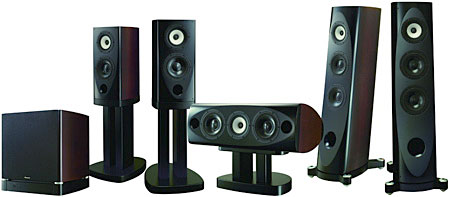Pioneer EX Series Surround Speaker System

But it's no secret that Japanese speakers are a tough sell in both North America and Europe, where the domestic competition is fierce. It isn't easy getting noticed amid the noise of 300 (or is it 500) other speaker manufacturers clamoring for attention.
Pioneer is making a serious attempt to change that equation. It all began a few years back with the TAD (Technical Audio Devices) Model-1. Outrageously expensive at $45,000/pair, it employed newly designed drivers produced by TAD, Pioneer's professional and high-end home speaker division. These included a unique, concentric (coaxial) midrange/tweeter unit that used Beryllium for both its midrange cone and tweeter dome, plus three additional custom-designed units for the bass and mid-bass. These drivers were mounted in one of the most elaborate enclosures ever devised, consisting of 52 sections of birch plywood stacked together to form an incredibly rigid, vertically laminated structure. The Model-1 will soon be superceded by a new model which uses a somewhat less elaborate cabinet configuration.
Pioneer has now drawn on the R&D performed for the TAD design to produce a more affordable (though hardly cheap) line of high-end speakers. The EX Series system reviewed here is built around the floor-standing S-1EX ($9K/pr.), the S-7EX center ($3,800/ea.), with the stand-mounted S-2EX ($3000/ea.) pulling surround duties and two S-W1EX subwoofers ($1,700/ea.) doing the heavy lifting in the bass department. Read on to find out just how much performance Pioneer has managed to chisel of the TAD block at a fraction of the price.
Design
While the new EX Series bares a more recognizably Japanese brand name—Pioneer rather than TAD—it is very much an international loudspeaker. The basic design was supervised by the director of engineering for TAD's Home Audio Division, Andrew Jones, who also worked on the Model-1 and subsequent TAD home designs with Brett Frank, TAD's senior mechanical engineer for home audio, and Toru Nagatani, chief engineer for both TAD's Home Audio and Professional Divisions. Andrew, who hails from the U.K. and is currently working at Pioneer's California facilities where much of the EX design was finalized, was at KEF in England U.K. for 11 years before joining Pioneer and TAD. The cabinets for the EX Series were designed in France but are built in China. The final assembly is also done in China. And to cap off the international flavor, as I write these words I have in front of me an English language EX Series brochure printed in Belgium!
The heart of all the full-range models in the EX Series is the Coherent Source Tranducer (CST). The EX version of this driver is derived directly from the design work done for the CST in the original TAD Model-1.
But Beryllium is both expensive and difficult to work with. To keep costs down, Magnesium is used for the midrange cone of the EX Series' CST in place of the Beryllium used in the Model-1. Apart from that, the fundamental design of both drivers is the same. You can see the complexity of the construction in the exploded diagram shown below. The driver is also designed for maximum airflow both behind the cone and around the voice coil to minimize compression and distortion at high power levels. The magnets are neodymium.

Pioneer claims response to 100kHz for the tweeter in the CST, and though the usefulness of such extended response is arguable, some markets now demand this sort of performance from high-end speakers. A rigid, black mesh grille sits over the extremely thin and delicate Beryllium tweeter, but since it can't be removed it isn't possible to determine how much effect it might be having on the tweeter's high frequency response—or if the 100kHz specification was determined with or without this protective grille. The grille does look fairly transparent. Look closely and you can easily see the tweeter diaphragm beneath it.
Designing such a coherent driver is not trivial, but it does offer one major advantage: there is no off-axis comb filtering of the sort that occurs with a tweeter and midrange that are physically displaced from one another (the arrangement used in 99% of the speakers on the market. Eliminating this displacement can pay particular dividends in a horizontally configured center channel speaker. TAD/Pioneer is not the first manufacturer to use such a driver, and the concept is currently used in speakers from Tannoy (possibly the first manufacturer to commercially employ a concentric tweeter) KEF, Thiel, Vandersteen, and Cabasse, among others.
Pioneer also has a long history of concentric speaker design and production. They used this configuration previously in the late "eyeball" midrange/tweeter, devised in the late 1990s for the intriguing Pioneer Elite Reference system I reviewed back in 1999. The latter was also the brainchild of Andrew Jones.
The same CST drive unit is used in both the S-2EX "bookshelf" and S-7EX center channel speakers. In the floor-standing S-1EX the CST is joined by a pair of 7" bass drivers utilizing rigid, damped aramid cones, neodymium magnets, and 65mm voice coils. The S-2EX uses one of the aramid-cone woofers and the S-7EX two, giving the latter the same driver complement as the S-1EX. All of these speakers use ported enclosures.





























































